
Modern Finery with
Ancient History

HISTORY
A nomadic heritage that immeasurably contributed to the repository of civilization has been brought to modern meaning. Now it has already reached the peak of perfection.
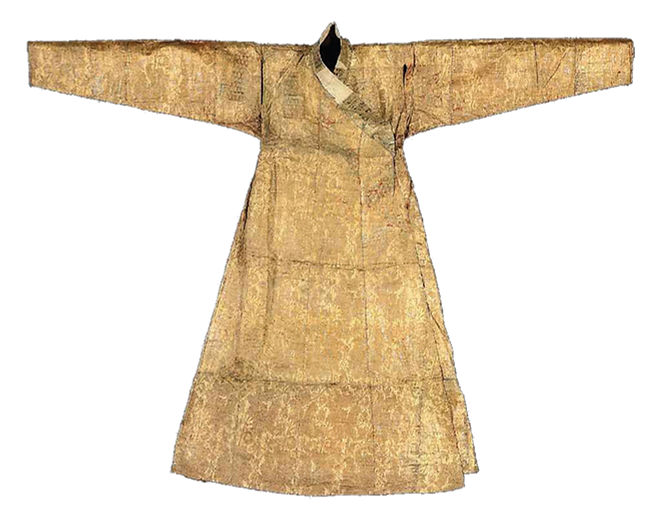

HUNNU AND MONGOLS
The Hunnu empire was established in 209 B.C. by Modun Shanyu. To protect from Hunnu attacks, Chinese Qin Shihuang, emperor of the Qin dynasty decided to build a great wall. Chinggis Khan once wrote in his letter to the famous Chinese philosopher Cheng Chun “No one has established a great empire like I did since Modun Shanyu’s time 1000 years ago.” Mongolians have incorporated the Hunnu symbolism of sacred sun and moon into the national emblem.


THE GREAT MONGOLIAN EMPIRE

A museum exhibit in the Museum of Great Britain is legally-defined clothes of Chinese and Korean royals during the Yuan dynasty.
Steppe nomads and the great empires that they established are meritorious, as they brought innovations such as pants, foot levers, banknotes, foreign passport, postal communication and free trade.
When Mongols conquering the Silk Road, and set PAX MONGOLICA, clothes-making reached a new level. Ancient writings say that during the Great Mongol empire years it was safe to go on the Silk Road even with a golden plate on your head. Mongols clothes represented their social ranks. In 1246, when Guyug has been glorified as an emperor, the attendees of a Great Khuraldai to elect the future emperor changed three different ceremonial clothes for three days. The great traveler Marco Polo noted in his memoirs “The first day it was white silk with golden streaks, the second day – red silk with golden streaks, the third day - a bright blue silk with golden patterns.”
IMPACT OF MONGOLS
A powerful dynasty influences nearby nations, while the Mongolian deel’s shape and design is being brought from generations to generations spreading throughout the territory of a great empire.

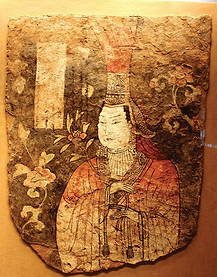

While the Great Mongol dynasty and Yuan dynasties founded by the steppe nomads were getting more and more powerful, the fahsion culture of captured nations became deeply influenced by the Mongols. Historically, two of the emperors, Munkh Khan in 1252 and Khubilai Khan in 1275, legitimized the immolation ceremonial clothes design. Recently, South Korean scientists are conducting research in this field. Professor Yim Mun Mi mentioned in her work: “the research on influence of foreign and North-East Asian ethnicites on the Mandarin traditional clothes was by the formation and development processes’’ and that from 300 years B.C. to 1930s, the countries, governments and people residing in Central and North-East Asia mutually influenced each other in clothes design.

DESIGN REAPPEARANCE
The Manchurian people, the Zurchid’s Golden country’s successors were ruling Mongolians and Chinese from the 17th century, which received its reflection from Chinese clothes.
he Manchurian clothes design had a similar shape with the Kidans’ deel of the 10th and 11th centuries, with high collar and buttons. This can be easily observed from the exhibit in the Mongolian National Museum. Also, there is proof that the hats of the Manchuria and Qing dynasties, which represented the social rank of a person, took their roots from the Yuan dynasty era. Among Mongolian emperors, portraits kept in Taiwan, the portraits of Ulziit Tumur Khan (1265-1307), and Zayat Khan (1304-1332) there were also decorations with stone and feather on top of the hat. In 1644-1759, when Mongolians were under Manchurian rule, the government officials and royal livery were legalized in “Law of Ruling the State of Outer Mongolia set by the Command.” This law has become a great influence in making a big change to Mongolian traditional clothes.



MONGOLIAN DEEL: DESTINY’S GAME
A GIFT INITIATED BY MARSHAL
CHOIBALSAN KHORLOO
One cannot imagine Mongolia and the Mongolian people without the deel. There is a formal tradition to give a full set of traditional clothes to high-level foreign government guests visiting Mongolia. The very first guest who received the traditional deel and hat was Henry Agard Wallace, the Vice President of United States of America, who visited Mongolia in 1944. The photos of Tsedenbal Yumjaa, the leader of the People’s Republic of Mongolia, who led the country for 32 years, believing in creating socialism, who had been rarely seen wearing traditional clothes, shows him being captured with government guests dressed in Mongolian deel.
A WEAPON OF NATIONALISM
When Mongolia fell under the influence of the Soviet Union and adopted a communist ideology, everything that was defined as “national” was mistreated, including traditional clothes. Since the new constitution of “Establishing socialism material and technique foundation” adopted in 1960, the deel has become the thing that only herders and elder people wear. Some of the nationalist intelligentsia were using the deel to show their wordless protest. But, as the deel is the most suitable wear for the nomadic lifestyle, it has been still widely used in countryside, becoming much simpler and humbler, until reaching better times.






DEEL: REVIVAL
When in 1990 a democratic system had been chosen, Mongolians started to wear traditional deels for every national holiday. For the Presidential swearing-in ceremony of Mongolia, the very first president Ochirbat Punsalmaa, a special deel was made, which symbolized the reestablishment of national ideas and traditions.
Since ancient times, Mongolian traditional clothes have expressed the status and rank of the owner. Age, gender, ethnic history, and traditions are also contained in one’s dress. The Mongolian clothes consist of deel, vest, belt, shoes, and hats that all contain symbolic meaning of prosperity.
MONGOLIAN TRADITIONAL CLOTHES

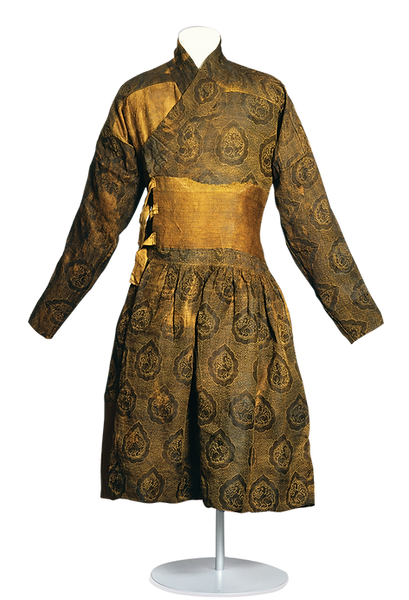


MONGOLIAN STITCHING AND EMBROYDERY
The Mongolian sewing technique has special traditional methods and requires a lot of handwork. Mongolian craft has a rich tradition of various stitches such as chain stitch, pearl chain stitch, slipstitch, backstitch, running stitch, fishbone stitch, satin stitch, stem stitch, blanket stitch, whip stitch, and a few dozen more.
BIAS TAPE
Bias tape, which is a decorative binding for Mongolian traditional clothes, makes them look beautiful and last longer.
On top of that, it represents a symbolic meaning of securing the fortune of its owner from fading away. Bias tape design differs not only by the person’s style, but by gender and age too. Single, double, or triple bias binding can be done in many different traditional ways such as wide taping, clamping, pushing, as well as edge-following techniques. An ornamental band can be used to decorate the part under the collar. Altogether, these make the deel achieve its perfect appearance.
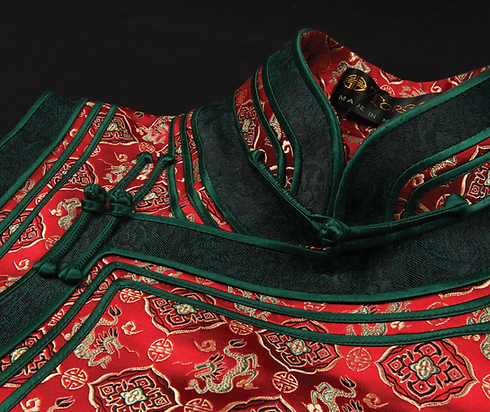

BUTTON &BUTTON LOOP
A light felt coat of the Kidans found in Bayankhongor province is archaeological proof that the traditional button and button loop were created in the territory of the ancient Mongols.
Throughout the millenniums, Mongolian button and button loop have been developed as very important details of the design. Japanese historian Shiba Ryoutaro once wrote, “While transmitting through Hungarian cavalry clothes and spreading in Europe at the end of the 17th century, Mongolian button and button loops transformed into the ribs-looking ornament on military uniforms.” The deel’s buttons and button loops have the same purpose as ordinary clothing buttons – to clasp the lapel. The button knot technique is a marvel created by the Mongolian mind. Shaped as a human fist, it symbolizes the wholeness of the Mongolian people. The button knot requires dexterous craftwork and acute eyesight. Since ancient times, the tailor’s skills have been measured by the quality of the buttons and button hoops they make.
BELT
Mongolians believe that the spirit of a man is located in the belt, so the wearing and taking off of the belt contains symbolic meanings.
The main use of Mongolian belts is for girdling the outer clothing. In addition, it is used as a holder of basic daily items needed for the nomad. Mongolians believe that the spirit of a man is located in the belt, so the wearing and taking off of the belt contains symbolic meanings. Since ancient times, there has been a tradition to decorate a man’s belt with golden and silver ornaments. Women don’t use belts, which is why women are called “busgui,” meaning “belt-less.” Mongolian men treasure their belts; thus, when swearing eternal friendship, they exchange their belts as a symbol of eternal unity. The story of Temuujin and Jamukha exchanging their belts in The Secret History of the Mongols is proof of this tradition.


Silk is a traditional Chinese luxurious fabric made from fibers produced by silkworms.

Combining tradition with modern elements to decorate the deel makes it look not just expensive, luxurious, and elegant, but truly enchanting.
ORNAMENT
Mongolians embellish their clothes and accessories with toreutics made of gold and silver inlaid with coral, pearl, and other gemstones.
Instead of investing wealth into property, people added it to their clothes and accessories, which were more suitable for their nomadic lifestyle. Traditional accessories such as the Mongolian wife’s headpiece or men’s knives involve the master’s intellect and the tailor’s skill in using gold, silver, coral, pearl, and other precious materials. Some female head accessories could weigh up to two or three kilograms of jewelry.



CLOTHING, ART, FINERY
Mongolian wear and traditional clothes were created as an expression of imagination, drawing from the rich treasury of the blessed old craftsmen.
The special feature of traditional Mongolian wear that perfectly matches the nomadic lifestyle is that it is made exclusively for the individual. It is not just a dress, but an independent work of art, which can be seen from its design. Moreover, the Mongolian traditional costume is a form of finery that incorporates a full range of techniques such as metal embossing, molding, weaving, and other traditional technologies.

At the dawn of a new millennium...
Torgo Salon resolved, at the dawn of the new millennium, to tailor Mongolian traditional clothes. The mission of Torgo is to inherit the national cultural features that capture the historical heritage of nomads and to share them with the world. Since its establishment, Torgo has developed a respected brand of haute couture national clothing made with high-quality luxury silk, adjusted to modern trends and new technology, becoming a famous and well-known trademark.

DEEL: HAUTE COUTURE
Mongolians wore the traditional deel daily in their lives, but there was never a mass production of deel.
Created by the maker’s vision and skilled hands, the production of each deel starts with choosing the silk, bias tape, lining, and design by the person who will wear it. Then, it is tailored specifically to the wearer’s measurements and body stance. This kind of exclusive custom-fitted garment is globally known as haute couture. Mongolians begin tailoring the deel on specific “good” days according to Eastern astrology. Commencing with a sacrament and infused with the Mongolian lifestyle, the deel rises as a symbol of prosperity and wellness.


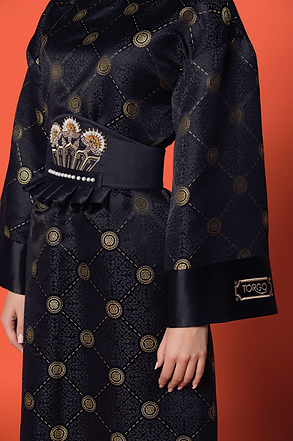
ORIGIN INNOVATION TORGO
Every innovation starts by returning to the roots. Torgo has proudly initiated the work of investigating, researching, and restoring the original design of the Mongolian deel, long covered by the dust of millenniums.


RECOGNIZED BY THE PEOPLE
A postage stamp is a valuable piece of paper that has been considered both a validation of a country’s independence and a chronological record of the nation that produced it. In 1924, Mongolia issued its very first postage stamp, and since that time, the country’s history has found its highlights on postage stamps. In 2013, Mongol Post created postage stamps featuring the artwork of TORGO’s designer Bold, presenting Mongolia to the world.

_edited.jpg)